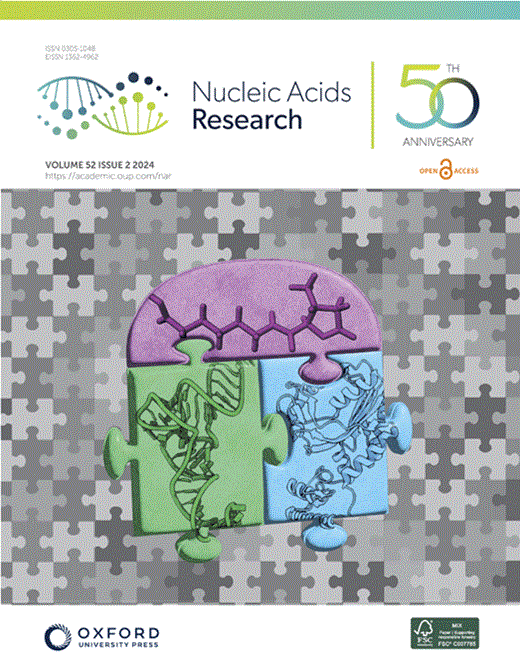解读异种核酸HNA的DNA聚合酶的结构见解
IF 13.1
2区 生物学
Q1 BIOCHEMISTRY & MOLECULAR BIOLOGY
引用次数: 0
摘要
异种核酸(XNAs)是天然核酸的非自然类似物,其典型核糖或脱氧核糖环被替代糖、同族结构甚至开环构型所取代。不断扩大的XNAs库为分子生物学以及诊断和治疗中的各种应用带来了巨大的希望。与天然核酸相比,XNAs的主要优势包括其增强的生物稳定性,优越的靶标亲和力和(在某些情况下)催化活性。自然系统通常缺乏转录、逆转录或复制XNAs的机制。通过核酸修饰酶的定向进化,特别是聚合酶(pols)和逆转录酶(RTs),已经克服了这一限制。尽管取得了这些进展,但由于缺乏结构信息,合成RT酶读取这些人工遗传聚合物的机制在很大程度上仍未被探索。这项研究首次揭示了与XNA 1,5-无氢己醇核酸(HNA)相互作用的进化的耐热性DNA pol的结构见解,揭示了与该酶的三元配合物中前所未有的HNA核苷酸构象。这些发现不仅加深了我们对HNA to DNA逆转录的理解,而且还通过精心设计为这种酶和类似酶的未来发展奠定了基础。本文章由计算机程序翻译,如有差异,请以英文原文为准。
Structural insights into a DNA polymerase reading the xeno nucleic acid HNA
Xeno nucleic acids (XNAs) are unnatural analogues of the natural nucleic acids in which the canonical ribose or deoxyribose rings are replaced with alternative sugars, congener structures or even open-ring configurations. The expanding repertoire of XNAs holds significant promise for diverse applications in molecular biology as well as diagnostics and therapeutics. Key advantages of XNAs over natural nucleic acids include their enhanced biostability, superior target affinity and (in some cases) catalytic activity. Natural systems generally lack the mechanisms to transcribe, reverse transcribe or replicate XNAs. This limitation has been overcome through the directed evolution of nucleic acid-modifying enzymes, especially polymerases (pols) and reverse transcriptases (RTs). Despite these advances, the mechanisms by which synthetic RT enzymes read these artificial genetic polymers remain largely unexplored, primarily due to a scarcity of structural information. This study unveils first structural insights into an evolved thermostable DNA pol interacting with the XNA 1,5-anhydrohexitol nucleic acid (HNA), revealing unprecedented HNA nucleotide conformations within a ternary complex with the enzyme. These findings not only deepen our understanding of HNA to DNA reverse transcription but also set the stage for future advancements of this and similar enzymes through deliberate design.
求助全文
通过发布文献求助,成功后即可免费获取论文全文。
去求助
来源期刊

Nucleic Acids Research
生物-生化与分子生物学
CiteScore
27.10
自引率
4.70%
发文量
1057
审稿时长
2 months
期刊介绍:
Nucleic Acids Research (NAR) is a scientific journal that publishes research on various aspects of nucleic acids and proteins involved in nucleic acid metabolism and interactions. It covers areas such as chemistry and synthetic biology, computational biology, gene regulation, chromatin and epigenetics, genome integrity, repair and replication, genomics, molecular biology, nucleic acid enzymes, RNA, and structural biology. The journal also includes a Survey and Summary section for brief reviews. Additionally, each year, the first issue is dedicated to biological databases, and an issue in July focuses on web-based software resources for the biological community. Nucleic Acids Research is indexed by several services including Abstracts on Hygiene and Communicable Diseases, Animal Breeding Abstracts, Agricultural Engineering Abstracts, Agbiotech News and Information, BIOSIS Previews, CAB Abstracts, and EMBASE.
 求助内容:
求助内容: 应助结果提醒方式:
应助结果提醒方式:


